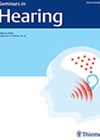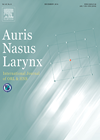
Journal Reviews
Be mindful of exposure
This is a topic which has been highlighted before in the Hearing Research series, as the evidence base regarding the specific impact of acoustic trauma on the auditory system has been expanding regularly in the last few years. This particular...
Third-party disability in cochlear implant users
Hearing loss causes changes for those experiencing it and the people who share in their everyday lives, often referred to as third party disability or caregiver burden. This study emphasises the notion that this phenomenon can be considered a disability,...
Provision of hearing support to people with dementia in care homes
The study suggests care home staff training in hearing care for residents with dementia is often not available or not considered a priority. Resources, facilities, training, staff capacity, capability and support vary widely. Care home provision also varies between social...
Are we all in the matrix?
In the entirety of training and in further practice, we are instilled with the premise of patient-centred care and individualised management plans based on informed consent. The question in the new age of telehealth/e-health is how to mimic that personalisation...
Does salvage treatment in sudden sensorineural hearing loss work?
Many treatment strategies for sudden sensorineural hearing loss (SSNHL) have been discussed, but the high spontaneous recovery rate (32-65%) of idiopathic SSNHL and differing treatment guidelines make comparing outcomes difficult. Systemic steroids are the most common first-line therapy with significant...
The ‘My Hearing Explained’ tool: audiologist and client perceptions
The study notes that the pure tone audiogram has been the primary clinical and counselling tool used by clinicians to assess and describe hearing thresholds to individuals and families since 1922. The Ida Institutes, ‘My Hearing Explained’ tool has become...
Hurdle jumping
This article deserves a little attention, rather like settling into conversation. As the writers state, listening is an effort and is a tricky field of study when combining multiple physiological measures. In order to gain an understanding, they suggest: consider...
Hearing difficulties and memory problems
Since the Lancet Commission report in 2020, we have all been aware that untreated hearing loss is potentially one of the biggest modifiable risk factors for dementia in midlife. Hearing loss is also associated with other risk factors for dementia,...
Advances in auditory implants
This article provides an overview of auditory implants. Implanted auditory devices may be classified into bone conduction implants (BCI) and active middle ear implants (AMEI) that stimulate cochlear hair cells, and cochlear implants (CI) that stimulate neural structures. CIs bypass...
Conductive hearing loss and temporal processing
This Turkish study looked at the effect of using hearing aids on auditory temporal processing (the ability of the hearing system to process the temporal properties of a sound stimulus in a certain period of time) in conductive hearing loss....
Ethnic inequalities in hearing aid use
Recent events, including the COVID-19 pandemic, have once again highlighted health inequalities experienced by people from ethnic minority backgrounds. Our Editors’ Choice paper shows that there are inequalities in hearing aid use and includes the stark finding that ethnicity is...
Sudden sensorineural hearing loss – who will get better?
Idiopathic sudden sensorineural hearing loss (ISSNHL) is a rare but potentially devastating condition. For patients presenting with this condition, prognosis is of paramount importance. Wu et al begin to address this issue by retrospectively studying 17 potential prognostic factors for...
















